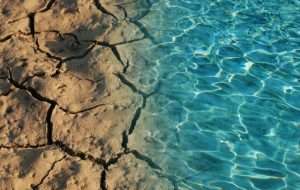This article was written by Dan Walters and originally appeared in CalMatters.
 Talk about timing.
Talk about timing.
Last Tuesday, Gov. Gavin Newsom extended and expanded his declaration of a drought emergency, just as the first in a series of storms rolled in from the Pacific to give California a much-needed respite.
Of course, it was just coincidence, one that reminds us of the fickle nature of the state’s water supply, dependent as it is on a few wet months each year. We’ll need an old-fashioned wet winter, with soaking rains and heavy snowfalls, to truly get some relief.
Our periodic droughts have become more frequent and more intense due to climate change and thus require us to become more resilient. However, we have neglected that imperative because it involves consensus that is difficult, or even impossible, to achieve in a state so large, complex and fragmented.
We once had consensus on water, which is why federal, state and local water agencies created a world-renowned array of reservoirs, canals and other facilities to store water when it was abundant for use during dry seasons or drought.
However, as the state’s population expanded to nearly 40 million thirsty souls and as agriculture, by far the biggest user of water, shifted to crops, such as grapes and nuts, needing more predictable watering, we continued to rely on an aging and inadequate infrastructure.
Newsom’s proclamation last week was more pro forma than substantial, saying “it’s critical that Californians across the state redouble our efforts to save water in every way possible.”
Well, yes, we should reduce water use to have a better chance of surviving a third year of drought. But fractional cuts in residential and commercial consumption, which is a very minor part of the overall water picture, are not the comprehensive strategy that the crisis demands.
Neither is Newsom’s boast that “the state is moving to protect our communities, businesses and ecosystems from the immediate impacts of the drought emergency while building long-term water resilience to help the state meet the challenge of climate change impacts making droughts more common and more severe.”
While those efforts might have an impact on the margins, they don’t confront the larger water issues.
If, for instance, we will be getting more of our precipitation as rain and less as snow, we must build more storage to replace the natural reservoir of mountain snowpacks. But even the most environmentally benign storage projects face decades of political wrangling.
This month, it was announced that the Sites Reservoir, a $5.2 billion off-stream water storage project northwest of Sacramento, is getting $80 million in federal funds for planning and engineering. If built, Sites would store up to 1.5 million acre-feet of Sacramento River flows during wet years for use when needed during dry periods.
Sites’ long slog to even the preliminary planning stage illustrates the difficulty of building the new storage that the state so urgently needs.
The Sites project has been kicking around for at least four decades but only lately has gotten serious attention and even if it gets the final green light, it might take decades to become operational.
Another major issue is water allocation. Since agriculture accounts for about three-fourths of California’s human use of water, it is the central factor in our hydrological future, and an overwhelmingly complicated one. It involves what crops are grown, the price that farmers pay and – the stickiest issue – whether historic water rights should be reevaluated and perhaps modified.
These are tough issues and the longer they are put off, the more intractable they will become.
This article was written by Dan Walters and originally appeared in CalMatters.


